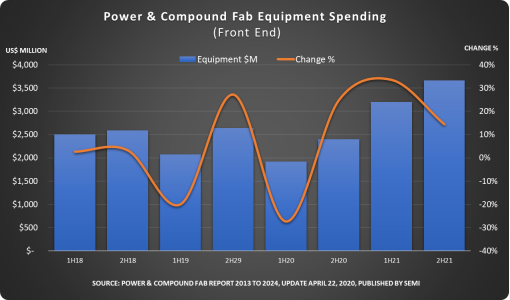STMicroelectronics has released three functional-safety packages that simplify development of safety-critical industrial, medical, consumer and automotive products based on STM32 and STM8 microcontrollers and microprocessors.
Power and Compound Fab Spending to Rebound in Second Half of 2020, Set New Record in 2021
The 2020 rally will help blunt a drop in annual spending, now projected at 8 percent, as fabs ride the COVID-19 recovery wave.
Vacuum Systems for the Treatment of COVID-19 Patients in Brazil
Brazil currently has the most confirmed COVID-19 cases in South America. Already in March, hospital capacities for intensive medical care of corona patients were expanded, and several field hospitals were established.
Aldec’s New HES FPGA Accelerator Board Targets HPC, HFT and Prototyping Applications plus Hits the ‘Price/Performance’ Sweet Spot
Aldec, Inc., a pioneer in mixed HDL language simulation and hardware-assisted verification for FPGA and ASIC designs, has launched a new FPGA accelerator board for high performance computing (HPC), high frequency trading (HFT) applications and high speed FPGA prototyping.
STMicroelectronics Simplifies Design and Boosts Safety with Highly Integrated Universal Car-Lock Controller
The STMicroelectronics L99UDL01 automotive universal door-lock IC integrates six MOSFET half-bridge outputs and two half-bridge gate drivers with protection and diagnostic functions that enhance safety, simplify design, and save space.
A Wireless Detonation System Designed to Increase Productivity And Safety at Open Pit Mines
Leti, a research institute of the CEA, and Davey Bickford, a worldwide leader in blasting solutions, announced today they have demonstrated a new, wireless system that offers increased safety, flexibility and productivity gains to the blasting market.
Global Silicon Wafer Area Shipments Edge Up in First Quarter 2020 Despite COVID-19 Headwinds
Worldwide silicon wafer area shipments rose 2.7 percent to 2,920 million square inches in the first quarter of 2020, compared with fourth-quarter 2019 shipments of 2,844 million square inches, but dropped 4.3 percent year-over-year, the SEMI Silicon Manufacturers Group (SMG) reported in its quarterly analysis of the silicon wafer industry.
Open-AirVentGT Emergency Ventilator Provides Patient Monitoring, Feedback Control
A research team at the Georgia Institute of Technology has created a prototype for a low-cost, portable emergency ventilator that uses electronic sensors and computer control to manage key clinical parameters such as respiration rate, tidal volume (the amount of air moved into and out of the lungs during each cycle), inspiration and expiration ratio, and pressure on the lungs.
Synopsys Introduces 3DIC Compiler, Industry’s First Unified Platform to Accelerate Multi-die System Design and Integration
Synopsys, Inc. (Nasdaq: SNPS) today introduced its 3DIC Compiler platform to transform the design and integration of complex 2.5 and 3D multi-die system in a package. It provides an unprecedented fully integrated, high-performance, and easy-to-use environment, offering architectural exploration, design, implementation, and signoff with signal, power, and thermal integrity optimizations, all in one solution.
Worldwide Smartphone Market Suffers Its Largest Year-Over-Year Decline in Q1 2020 Due to COVID-19
Worldwide smartphone shipments decreased 11.7% year over year in the first quarter of 2020 (1Q20), according to preliminary data from the International Data Corporation (IDC) Worldwide Quarterly Mobile Phone Tracker.

